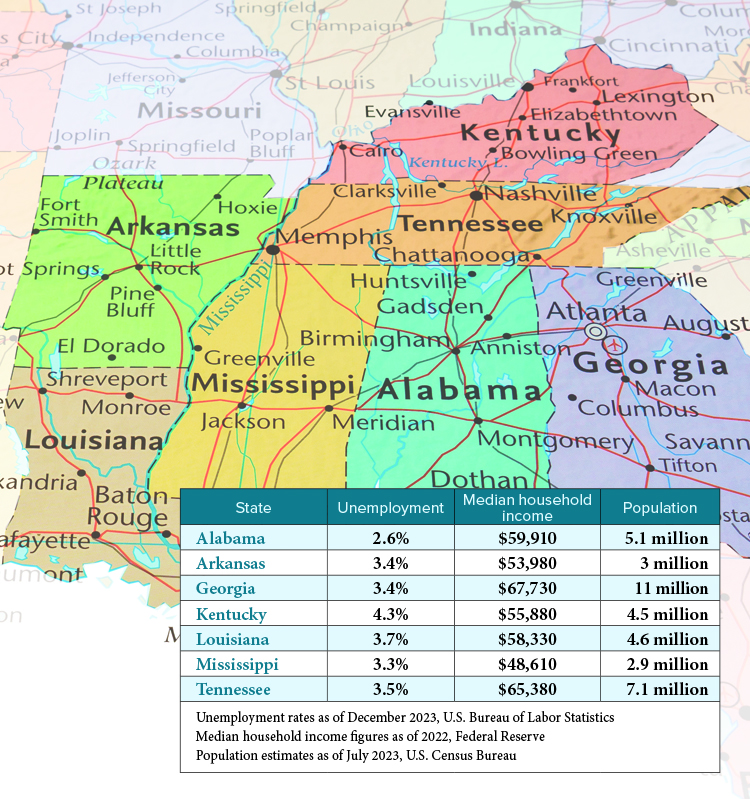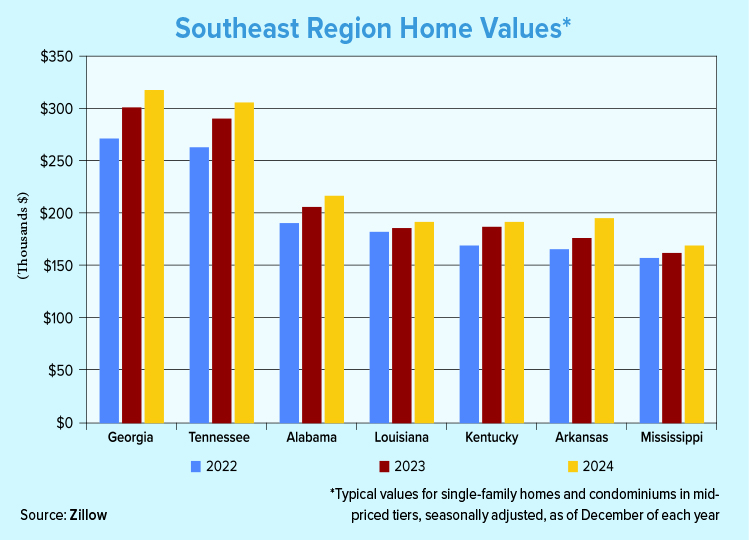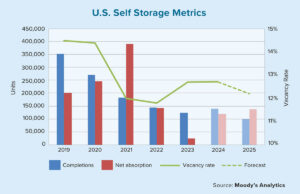Covered in Spanish moss and drenched in Southern charm, the Southeast is a deeply iconic region in American culture. The region stretches from the picturesque cobblestone squares of Savannah to Nashville’s legendary music scene and New Orleans’ French Quarter. The Civil Rights movement, Jazz, soul food, the works of William Faulkner, Harper Lee and others were all born here.
The Southeast, encompassing the states of Alabama, Arkansas, Georgia, Kentucky, Louisiana, Mississippi and Tennessee, is incredibly diverse in its economies, ecologies and populations. Nashville, Atlanta and New Orleans are economic anchors in the region, but it’s also home to countless rural communities. The median household income ranges widely between these states, from about $49,000 in Mississippi to nearly $68,000 in Georgia.
Long an affordable region to live, with lower housing prices and cost of living, the South has seen an influx of population in recent years as Americans move out of higher-cost states. The COVID-19 pandemic exacerbated this trend, and Southeast states saw the greatest positive population changes. A report on pandemic growth regions from the Economic Innovation Group noted strong growth in the Southern Triangle (encompassing parts of Tennessee, Alabama and Georgia) and the South Atlantic, which includes coastal Georgia. And of course, these states’ closest neighbors — Texas and Florida — are pulling in the most new residents in the nation.

Similarly, a Bank of America report from December noted that the South outgrew the overall U.S. economy between 2017 and 2022. It also has arguably the strongest labor market of any region, according to the report, with low unemployment and numerous job openings.
Aspiring homeowners love these Southeastern states, especially if they’re bringing higher salaries to the region. Homes are more affordable in the Southeast than the nation overall. The highest median sales price in the region — for the state of Tennessee — reached $364,700 in January, as compared to the national median of $417,700. The lowest median price, in Arkansas, was just $239,300.
Three cities in the region made the top 10 on the 2024 Aspiring Home-owners report from PBS show and home remodeling brand “This Old House,” which ranked 148 cities based on affordability, downpayments, mortgage insurance premiums and more. Clarksville, Tennessee, was in second place, followed by Jackson, Mississippi, at third. Mobile, Alabama, came in eighth place. Thanks to its affordability, the Southeast boasts high homeownership rates.
Not everything is peaches and cream in the Southeast. While the overall economy in most states is growing, poverty is a real issue in the region, especially in rural areas. About one in five counties in the South experiences “persistent poverty,” according to a November report in The Conversation authored by two Southern university professors. Former agricultural and manufacturing hubs are struggling as jobs are lost to outsourcing and automation, and health and educational outcomes are lower than average.
This is undoubtedly an issue. Optimists believe that as the economy and population shifts from North to South and from big cities to “second-tier” and smaller cities, it could revitalize the area. Inarguably, the economic and cultural influence of the Southeast is already growing. ●

Like much of the rest of the nation, home values continued to rise in the Southeast last year. But these states remain relatively affordable holdouts, with typical home values below $200,000 in four of these seven states, according to Zillow data.
Median home sales prices tell a different story, with prices significantly exceeding typical home values in each state. For example, while Mississippi had the lowest typical home value at $169,792, the median sales price in January was $228,500. Georgia, with the region’s highest typical home value at $317,982 had a median sales price of $351,300.
Median home prices rose in every state but Louisiana, which saw a 0.31% decrease year-over-year. Kentucky saw the greatest growth, with 6.8% growth in median sales price YOY, followed closely by Georgia with 6.6%. Arkansas and Tennessee’s prices rose 5.6% and 5.4% respectively, followed by Alabama (3.2%) and Mississippi (1.9%).
Some metros within the region saw wild growth in 2023. North Little Rock, Arkansas, was the fastest growing metro in the region, with the median sales price jumping a jaw dropping 55.5% between January of 2023 and 2024. It remains relatively affordable, however, with a post-increase median sale price of $164,097. Enterprise, Alabama, wasn’t far behind, with the median price rising 50% YOY to $255,000, and Hopkinsville, Kentucky, was in third, with prices climbing 42.2% YOY to $270,000.
What the Locals Say
I just looked at the Q1 numbers and I’m gonna more than double what I did last year (in Louisville, Kentucky.) I think this year is going to be considerably better than last year for a few reasons. Last year, if you recall, rates had just jumped from October through January. Going into 2023, a lot of people were just shellshocked. They couldn’t believe rates went up so fast.
This year, the rates are frankly in about the same spot. The difference is that people have grown accustomed to it. The other thing that could potentially make it an exceptional year is when the Fed pulls back interest rates. In Q4, if rates get down to 6% and you can refinance all these 7.5% almost 8% loans that we’ve done in the last year and a half, that’s going to add to your volume considerably.
There’s so much demand sitting on the sidelines. This past week, we had a listing go up for $400,000 and there were 27 offers on it and it went for $465,000. No appraisal, no inspections. That’s a sign of probably what’s to come this spring and summer. There’s so much demand, limited supply and the supply is not going to change until rates come down.
You’ve got current homeowners at 2%, 3%, 4% that are not going to move for a 7% interest rate. The question becomes, ‘When will they move?’ The answer is put a five in front of it, and I think people will start thinking about it.

Branch manager
Interlinc Mortgage Services, LLC
Sources: Bank of America, The Conversation, Economic Innovation Group, Federal Reserve Bank of St. Louis, Redfin, This Old House, U.S. Census Bureau, The Washington Post, Zillow






